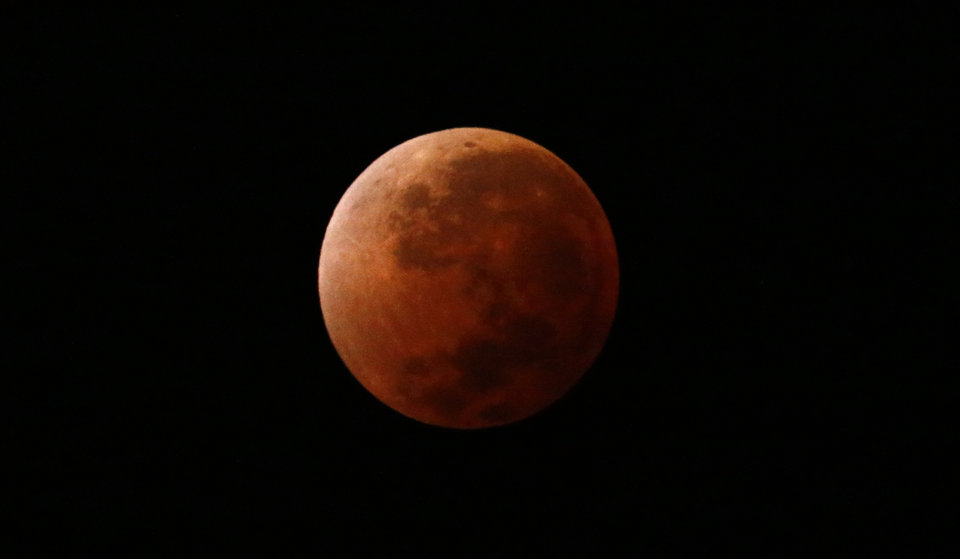|
|
| The moon is seen as it begins a total lunar eclipse that will turn the moon red over Buenos Aires April 15, 2014. REUTERS/Marcos Brindicci |
A total lunar eclipse , or blood moon, will happen overnight on July 27.
The eclipse is slated to last nearly 1 hour 43 minutes — the longest in about a century.
Total lunar eclipses and total solar eclipses are essentially the reverse of one another; the difference is the relative positions of the Earth, sun, and moon.
A majority of Earth is in for an astronomical treat on Friday: the longest total lunar eclipse, also known as a blood moon, in a century.
At 17:14 Universal Time that night (3:37 p.m. ET), the Earth will slip directly between the sun and moon, casting an orange-red shadow on the full moon. From the moon’s vantage point, the Earth would appear to be surrounded by a 25,000-mile-around ring of fire.
This event is not to be confused with a total solar eclipse like the one that was visible across a swath of the continental US last summer.
Total lunar eclipses and total solar eclipses are essentially the reverse of one another. However, their appearances are very different.
Here’s what happens during each type of eclipse
During a total solar eclipse, the moon passes between Earth and the sun, casting a small, dark shadow on our planet. For those watching on Earth, the moon appears to cover the sun, with a ring of the sun’s light surrounding the moon. Looking directly at that light requires special glasses to protect the eyes from the sun’s brightness.
If you saw the most recent solar eclipse (full or partial), you’ll remember that the circle of light looks colorless. That’s because the moon has no atmosphere. Atmospheres, similar to glass lenses, can refract sunlight.
During a lunar eclipse, however, the Earth passes between the moon and the sun, casting its shadow — known as the umbra — onto the moon. During this event, it’s not dangerous to look up at the moon.
|
|
| A diagram of the Earth, moon, and sun during a total lunar eclipse or “blood moon.” Shayanne Gal/Business Insider |
Unlike the moon, Earth is surrounded by a blanket of air, which refracts the sun’s light in a way that makes the moon appear orange-red. That’s why lunar eclipses are also called blood moons.
By volume, about 80% of Earth’s atmosphere is made of nitrogen gas, or N 2 , and most of the rest is oxygen gas, or O 2 . Together, these gases take white sunlight — a mix of all colors of the spectrum — and scatter around blue and purple colors. Human eyes are much more sensitive to blues than purples , which is why the sky looks blue and the sun yellow to us during daylight hours.
During a sunset or sunrise, sunlight reaching our eyes has passed through a lot more atmospheric gas, and this effectively filters out the blues and makes the light appear orange or even red.
A similar thing happens during a lunar eclipse. Earth’s atmosphere bends and focuses the sun’s light into a glowing, cone-shaped shadow — the umbra.
The red color is never quite the same from one lunar eclipse to the next due to natural and human activities that affect Earth’s atmosphere.
“Pollution and dust in the lower atmosphere tends to subdue the color of the rising or setting sun, whereas fine smoke particles or tiny aerosols lofted to high altitudes during a major volcanic eruption can deepen the color to an intense shade of red,” David Diner , a planetary scientist at NASA’s Jet Propulsion Laboratory, wrote in a blog post in 2010.
Where and when to see the total lunar eclipse
If the weather cooperates, most of eastern Africa, the Middle East, and central Asia should see the full and total lunar eclipse on Friday. Scientists in Antarctica should also have a great view.
Europe, eastern Asia, Australia, Indonesia, and other regions will enjoy a partial lunar eclipse, where the moon passes partly through Earth’s shadow.
North America will be out of luck, though, since the moon will be below the horizon. People there can watch on one of several live webcasts.
|
|
| A map of locations where the total lunar eclipse of July 27 and 28, 2018, will be visible.Fred Espenak/NASA Goddard Space Flight Center |
The partial eclipse begins when the moon first touches the penumbra or outer shadow of Earth. According to NASA , that should happen at 17:14 Universal Time on July 27.
The total eclipse — when the moon is fully inside the red-hued umbra of Earth — starts at 19:30 UT and ends at 21:13 UT. That’s a full 1 hour 43 minutes, which is just four minutes shy of the longest total lunar eclipse possible, according to EarthSky.
The partial eclipse will resume immediately afterward, as the moon passes out of Earth’s shadow, and the whole event will be over at 23:28 UT (early on July 28, depending on where you live).
The next time a total lunar eclipse will last this long will be in the year 2123.
source: businessinsider.com
